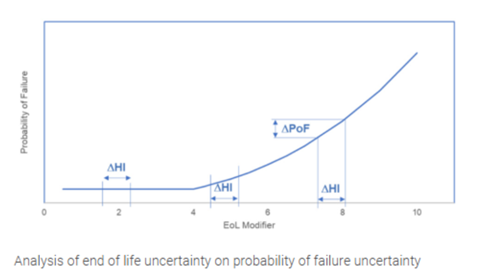TNOMS: Determining uncertainty in asset degradation and modelling for transmission network operators
-
24 June 2021
-
EA Technology
Britain’s Electricity Transmission Network is owned and maintained by three Transmission Companies (National Grid Electricity Transmission plc (NGET), Scottish Power Transmission Ltd (SPT), Scottish Hydro Electric Transmission plc (SHE-T).
This was a joint project working with two of the three of Great Britain’s (GB) Transmission Operators, namely Scottish Hydro Electric Transmission and SP Transmission, who are responsible for the 132kV, 275kV and 400kV electricity network in Scotland.
Challenges
The RIIO (Revenue = Incentives + Innovation + Outputs) regulatory framework places emphasis on incentives and outputs to drive innovation that is needed to deliver a sustainable energy network to customers.
Outputs are a fundamental element of the RIIO framework, as they are used to monitor each Transmission Operator’s (TOs) performance for the delivery of end services to customers. The Network Output Measures (NOMs) are binding secondary outputs which show that the TOs are providing customers with long-term value for money through a set of early warning measures or lead indicators. These assess the underlying performance of the transmission system and are designed to demonstrate that the TOs are targeting investment in the right areas to manage network risk effectively. The NOMs outputs include, amongst others, asset health, criticality and risk. Due to significant historical differences.

in the approaches taken to model asset health and probability of failure, the three transmission organisations in GB could not agree on a unified approach that was acceptable to all three parties. While both SPT and SHE-T use Condition Based Risk Management (CBRM), a methodology devised by EA Technology, NGET use their own in-house methodology. Therefore, a decision was made that each company would be permitted to use their own methodologies for deriving health and probability of failure provided they could demonstrate the results were comparable. A unified approach was adopted for the assessment of the consequences of failure.
In early 2017, SHE-T and SPT engaged the services of EA Technology to align the consequence element of their bespoke CBRM models with the requirements of NOMs, and to assist with calibration, testing, validation activities (CTV); key activities required by the Regulator to ensure the models produced results that were directly comparable.
Solutions
EA Technology provided input to refine the definition of the common NOMs methodology to enable each TO adopt their own approach to defining asset health and probability of failure, whilst ensuring that the results would be comparable. This involved liaising with the National Grid Electricity Transmission at all stages of the project. During the course of the project we:
• Attended meetings with the Regulator, in order to provide technical support to our clients to describe the details of the CBRM methodology and answer any questions that arose;
•Specified a CBRM model design that was aligned to the common approach, but which ensure minimal impact on the existing bespoke CBRM models;
• Implemented the new models following testing to ensure compatibility with the new NOMs methodology;
• Responded effectively and quickly to updates to the methodology;
• Ran calibration exercises using the new models to evaluate the outputs using real data from all three transmission companies;
• Attended calibration workshops to compare the results of the calibration exercises, and recommended where changes to calibrations were required to ensure better alignment;
• Combined the outputs from the calibration workshop with the latest version of the NOMs methodology to produce a comprehensive CTV plan;
• Undertook uncertainty analysis to quantify the standard error of the risk associated with data gaps for the asset population;
• Collation of the results of the uncertainty analysis for SHE-T and SPT submission to the regulator Ofgem
Outcomes
The successful delivery of the new CBRM models in line with the NOMs requirements has enabled SHE-T & SPT to meet their regulatory report obligations on asset health, criticality and risk reporting.
The rigorous and disciplined approach that was used to evaluate the results of the models during the calibration, testing, validation and uncertainty analysis activities helped assure the Regulator that the differing approaches adopted across GB produce comparable results, and can sit side by side to meet the requirements of NOMs. The collaborative approach adopted by all three transmission companies
highlighted modifications to calibration that would not have necessarily been detected otherwise and ensured alignment across all three organisations, which would not have been possible without the close co-operation between all the parties involved in this project.